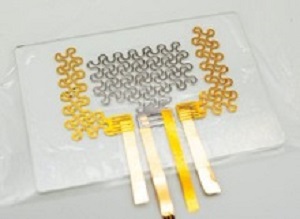 A new wearable technology developed at the University of Texas and made from stretchy, lightweight material measures cardiac health by taking electrocardiograph and seismo-cardiograph readings simultaneously.
A new wearable technology developed at the University of Texas and made from stretchy, lightweight material measures cardiac health by taking electrocardiograph and seismo-cardiograph readings simultaneously.
It could make heart health monitoring easier and more accurate than existing electrocardiograph machines – a technology that has changed little in almost a century.
Developed by engineers at The University of Texas at Austin and led by Nanshu Lu in the Cockrell School of Engineering, this is the latest incarnation of Lu's electronic tattoo technology, a graphene-based wearable device that can be placed on the skin to measure a variety of body responses, from electrical to bio-mechanical signals.
The device is so lightweight and stretchable that it can be placed over the heart for extended periods with little or no discomfort. It also measures cardiac health in two ways, taking electrocardiograph and seismo-cardiograph readings simultaneously. Most of us are familiar with the electrocardiogram (ECG), a method that records the rates of electrical activity produced each time the heart beats.
Seismo-cardiography (SCG) is a measurement technique using chest vibrations associated with heartbeats. Powered remotely by a smartphone, the e-tattoo is the first ultrathin and stretchable technology to measure both ECG and SCG.
"We can get much greater insight into heart health by the synchronous collection of data from both sources," said Lu, an associate professor in the departments of aerospace engineering and engineering mechanics and biomedical engineering.
ECG readings alone are not accurate enough for determining heart health, but they provide additional information when combined with SCG signal recordings. Like a form of quality control, the SCG indicates the accuracy of the ECG readings.
Although soft e-tattoos for ECG sensing are not new, other sensors, such as the SCG sensor, are still made from non-stretchable materials, making them bulky and uncomfortable to wear. Lu and her team's e-tattoo is made of a piezoelectric polymer called polyvinylidene fluoride, capable of generating its own electric charge in response to mechanical stress. The device also includes 3D digital image correlation technology that is used to map chest vibrations in order to identify the best location on the chest to place the e-tattoo.
The e-tattoo has another advantage over traditional methods. Usually an ECG measurement requires going into a doctor's office, where heart health can be monitored only for a couple of minutes at a time. This device can be worn for days, providing constant heart monitoring.
Lu and her team are already working on improvements to data collection and storage for the device, as well as ways to power the e-tattoo wirelessly for longer periods. They recently developed a smartphone app that not only stores the data safely but can also show a heart beating on the screen in real time.
Abstract
Seismocardiography (SCG) is a measure of chest vibration associated with heartbeats. While skin soft electronic tattoos (e‐tattoos) have been widely reported for electrocardiogram (ECG) sensing, wearable SCG sensors are still based on either rigid accelerometers or non‐stretchable piezoelectric membranes. This work reports an ultrathin and stretchable SCG sensing e‐tattoo based on the filamentary serpentine mesh of 28‐µm‐thick piezoelectric polymer, polyvinylidene fluoride (PVDF). 3D digital image correlation (DIC) is used to map chest vibration to identify the best location to mount the e‐tattoo and to investigate the effects of substrate stiffness. As piezoelectric sensors easily suffer from motion artifacts, motion artifacts are effectively reduced by performing subtraction between a pair of identical SCG tattoos placed adjacent to each other. Integrating the soft SCG sensor with a pair of soft gold electrodes on a single e‐tattoo platform forms a soft electro‐mechano‐acoustic cardiovascular (EMAC) sensing tattoo, which can perform synchronous ECG and SCG measurements and extract various cardiac time intervals including systolic time interval (STI). Using the EMAC tattoo, strong correlations between STI and the systolic/diastolic blood pressures, are found, which may provide a simple way to estimate blood pressure continuously and noninvasively using one chest‐mounted e‐tattoo.
Authors
Taewoo Ha, Jason Tran, Siyi Liu, Hongwoo Jang, Hyoyoung Jeong, Ruchika Mitbander, Heeyong Huh, Yitao Qiu, Jason Duong, Rebecca L. Wang, Pulin Wang, Animesh Tandon, Jayant Sirohi, Nanshu Lu
[link url="https://news.utexas.edu/2019/06/20/new-e-tattoo-enables-accurate-uninterrupted-heart-monitoring-for-days/"]University of Texas at Austin material[/link]
[link url="https://onlinelibrary.wiley.com/doi/full/10.1002/advs.201900290"]Advanced Science abstract[/link]
